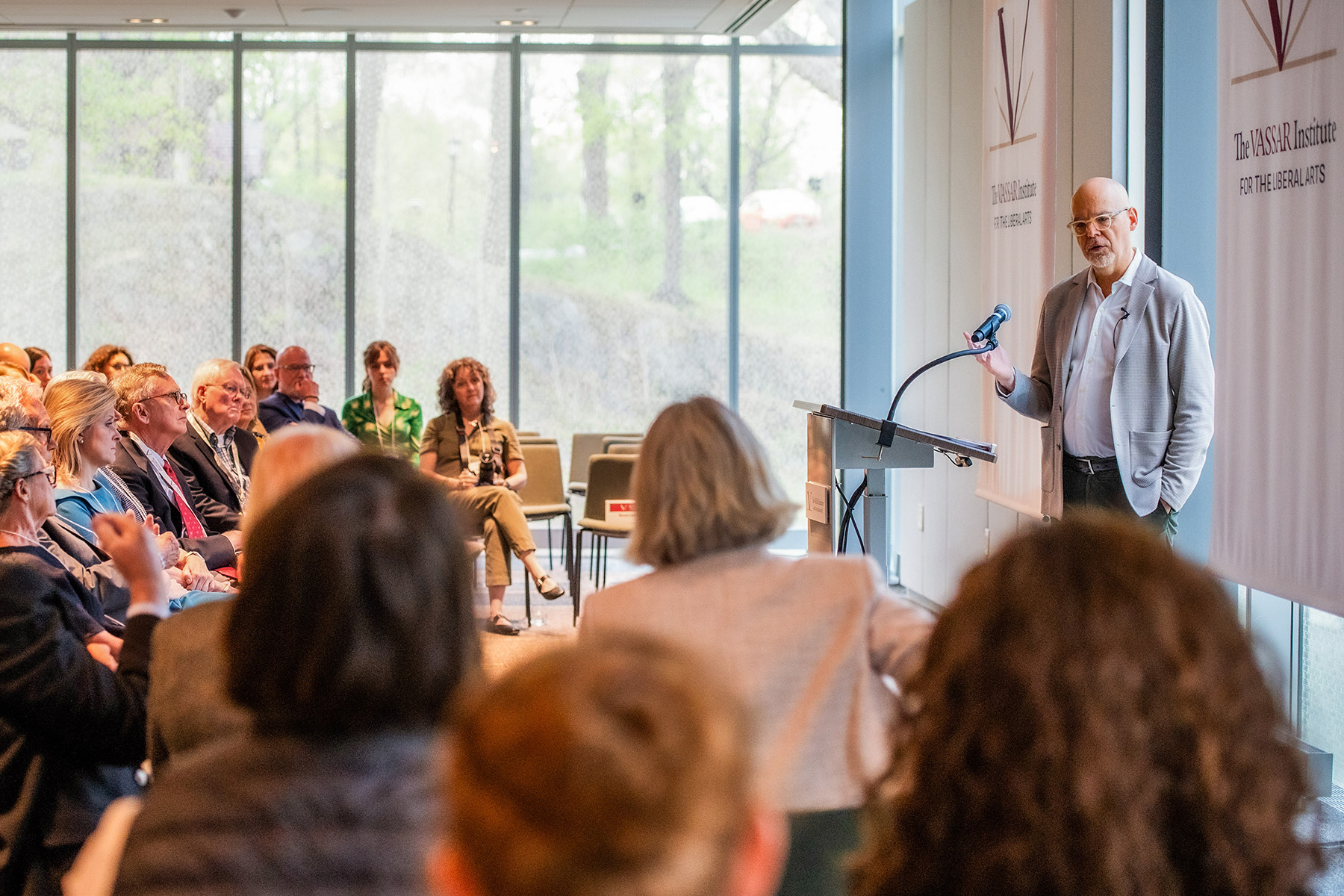A Half Century Later: Understanding the Impact of the Vietnam War
Half a century after the end of the Vietnam War, the lessons learned and, as is increasingly revealed, the lessons not learned, continue to reverberate throughout American culture, politics, and military strategy. Insights born of both first-hand experience and 50 years of research offer rich opportunities for those who continue to study the impact of what Pulitzer Prize-winning author Fred Logevall, Laurence D. Belfer Professor of International Affairs and Professor of History at Harvard University, calls this “very crucial chapter in American history.”

Photo by Kelly Marsh
As keynote speaker, Logevall kicked off Remembering the American War in Vietnam: A Fifty-Year Retrospective on April 24–27 at The Vassar Institute for the Liberal Arts. Convened by Robert K. Brigham, Vassar’s Shirley Ecker Boskey Professor of History, the conference brought together distinguished presenters who shared their experiences and insights on a wide range of issues, including domestic politics, foreign relations, military strategy, and the roles of women and race.
“We grew up with the war in so many ways—in our families and communities, on TV,” said Brigham of the 73 million baby boomers who came of age in the 1960s and 1970s. “It permeated the national consciousness as much as the music that became the soundtrack of that era. It was impossible to avoid, and it’s still resonating.”

Photo by Kelly Marsh
In his Thursday evening presentation, Logevall contended that today’s politics of resentment stem from the era when Americans first learned that their leaders were lying about the war.
“I suggest that many of the troubles that plague our nation today—alienation, resentment, cynicism, the mistrust of government, the breakdown of civil discourse and of civic institutions, and the lack of accountability in powerful institutions—have their roots in the Vietnam War era,” he said. “You could argue that Americans went from naivete at the outset of the Vietnam era to cynicism—and cynicism, which alienates us from the government, threatens democracy because it destroys the power of the people to believe in change, and to work for change.”
According to Greg Daddis (Colonel, U.S. Army retired), Professor of History and USS Midway Chair in Modern U.S. Military History, San Diego State University, history demonstrates that most wars have to be won politically if they’re to be won at all. “The Vietnam War revealed that the capacity of America to reshape political and social communities abroad is not limitless,” he said, “and that it is a mistake to privilege military power over economic or diplomatic efforts.”
“Since 1990, Vietnam and the U.S. have been working toward renewed relations,” he said, pointing to the current administration’s initial refusal to have a diplomatic presence at receptions in Saigon. “It says something larger about this administration’s lack of confidence in America’s place in the world.”
Remarks by Peter Osnos—author, journalist, publisher, former foreign and national editor, The Washington Post—dovetailed with both Daddis and Logevall. “There are ironies galore,” he said. “What we went through in Vietnam should have given us real lessons, but the lessons were not learned. We were ignorant of Vietnam’s history, context, and language when we went in, and it was the same in Iraq and Afghanistan, although they were in different parts of the world and of a much smaller scale. We left in one in frustration, the other in failure.”
The relatively minor imprint America’s two most recent wars left on the U.S. psyche can also be attributed partly to the lack of a draft, which ended in January 1973. In Vietnam, drafted soldiers from all classes of society accounted for approximately one-third of those serving and were a product of the context of growing social activism back home—the struggle for civil rights and women's rights, and the changing nature of youth in American society. It was also the first time any U.S. war was fought from the beginning with a fully and purposefully racially integrated U.S. military, according to Beth Bailey, Foundation Distinguished Professor and Director of the Center for Military, War, and Society Studies at the University of Kansas. For a time, the military insisted on seeing only one color in Vietnam—olive drab—and went so far as to remove racial designations from its forms.
“During the 1960s, lots of Americans—people in uniform and civilians—saw the U.S. military as a model of racial progress,” Baily explained. “But the institution was definitely not exempt. It did not stand apart from the broader society from which it drew its members, and from which it was going to return its members.”

Photo by Karl Rabe
Toward the end of the 1960s, the perception of colorblindness, fueled by Black Freedom and Black Power movements back home, was impossible to maintain.
“The war was increasingly seen as failing, and men forced together for 24 hours a day, under all sorts of pressure, led to combat refusal, high levels of people going AWOL, drug and alcohol abuse, and racial conflict and violence,” Bailey said. “It began to challenge the ability of the US Army to fulfill its mission of national defense.”
In response, the military instituted race training, handbooks, and seminars and, in 1971, established the Defense Race Relations Institute. Understanding race as a critical issue also brought the awareness that culture also mattered—and that the hair products, cosmetics, magazines, and music available in the retail stores on bases (or PXs) presumed whiteness. As the third or fourth largest retail entity in the country, the PX guaranteed sales worth billions of dollars for all sorts of products, and when those products for Black troops were brought in, the impact on Black businesses was massive.
“That awareness also led to affirmative action programs within the Department of Defense that brought more people of color into enlisted ranks, and also as judges and lawyers,” Bailey explained. “These were very successful programs that continued up until the most recent administration.”
The military and civilian organizations that sent women to Vietnam also had to grapple with rapidly changing ideas about gender and sexuality. Women chose to go to Vietnam for a variety of reasons, including a sense of duty and opportunities for independence, as nurses saving lives, soldiers in the Women’s Army Corps, or participants in the Red Cross’s Supplemental Recreational Activities Overseas Program. Regardless of the specific work that they performed, the expectations imposed upon them by a long history of women's work both in and out of the service belied the gravity of the work they were doing.
“All American women in the war felt the expectation that they be conventional symbols of American womanhood, even as they endured wartime conditions and performed work that challenged those very traditional assumptions,” said LCpl. Kara Vuic, Benjamin W. Schmidt Professor of War, Conflict, and Society in 20th-Century America, Texas Christian University.
Their Vietnam experience—from oppressive hierarchies and a lack of formal recognition to routine harassment—also played out when they returned home. Many not only felt out of step with their peers but saw their contributions devalued in civil society, both professionally and personally, and it often took them decades, if ever, to achieve recognition. The most tangible legacies in this struggle are reforms within the VA, including the establishment of the first women’s health clinic and the Vietnam Women's Memorial, dedicated in 1993, after decades of persistence.
Today’s military, despite the current administration’s devaluation of women’s contributions, relies on women to fulfill every role.
“The war upended a lot of the conventions that women had been expected to embody and to represent,” Vuic said, “but in our national memory, we still haven't reconciled exactly what they’ve done. The lasting image of women in Vietnam is still a mix of convention and progress. It’s still pretty complicated.”